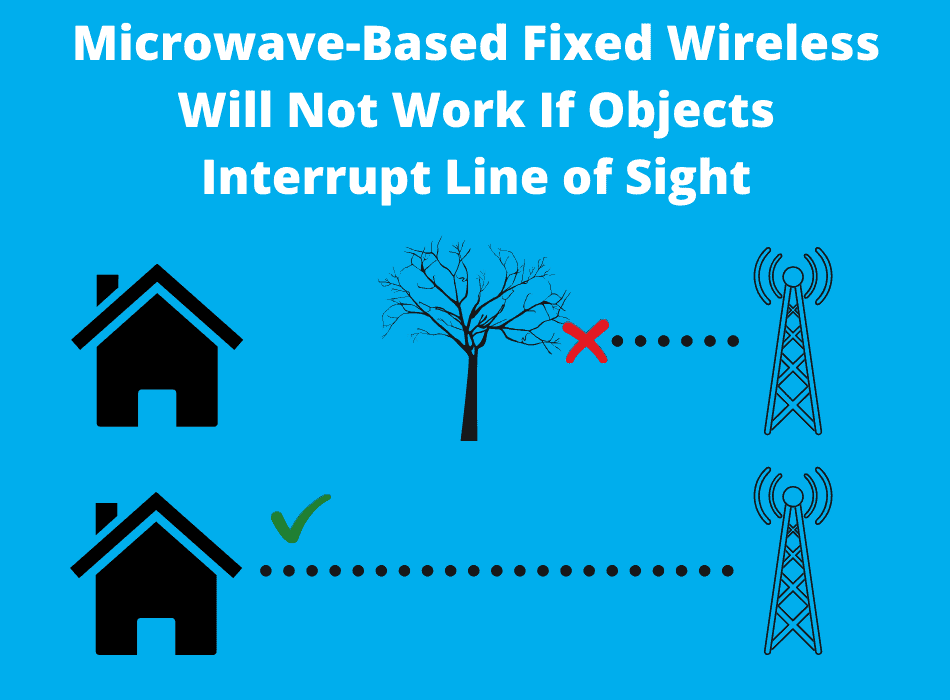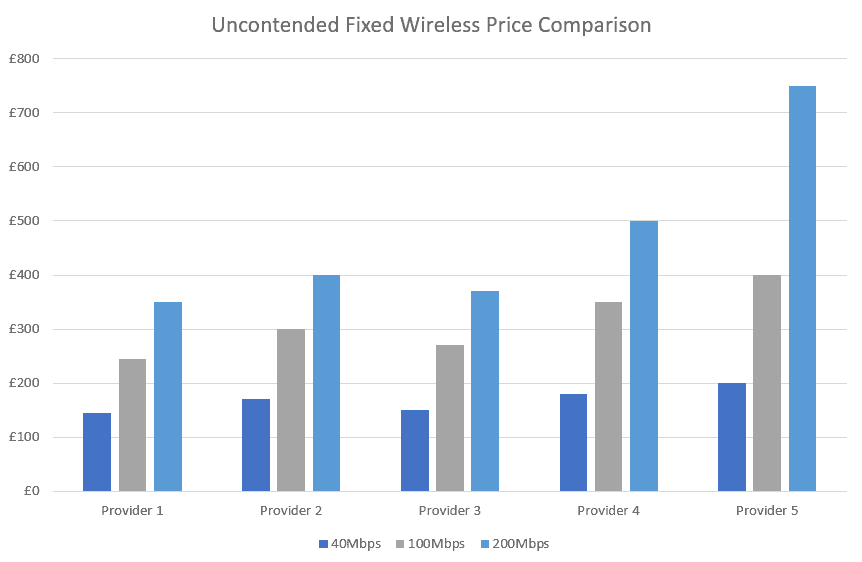As we’ve discussed in plenty of detail before, there aren’t a lot of options when it comes to internet in rural areas. Your choices are rather limited. It really comes down to three options in most cases: DSL, fixed wireless, and satellite. I’ve previously compared DSL and fixed wireless, but how do fixed wireless and satellite compare?
Is fixed wireless better than satellite? Fixed wireless is better than satellite for several reasons, from higher speeds to greater reliability.
While that succinctly answers the question, there are several points to consider when comparing fixed wireless and satellite. To truly compare the technologies, it’s important to understand what they both are and how they compare. By the end of this blog post, you’ll know all you need to know about fixed wireless and satellite internet and why fixed wireless is better!
To jump straight to our comparison, click one of the links below:
What Is Fixed Wireless?
As you’ll know, most internet access is reliant on a physical connection. Whether it’s ADSL, which relies on the copper wire between the roadside cabinet and your property, or FTTP, which relies on the fibre cable connecting your building and the exchange, most internet services need a physical connection.
Fixed wireless is different, which is one of the reasons that it’s such a popular choice in rural areas. A fixed wireless connection uses microwaves, rather than cables or wires. A fixed wireless base station houses radios that communicate wirelessly with receivers fitted to customers’ buildings. As long as there is line of sight between the transmitter and the receiver, a wireless connection can be set up in most cases.

With fixed wireless internet access, you can still enjoy superfast speeds despite the fact that you do not have a physical connection installed. A contended fixed wireless connection will give you speeds similar to FTTC. On an uncontended connection, speeds of up to 2Gbps are possible.
I think that fixed wireless internet access is the best option for businesses and homes in rural areas. You get incredible speeds without the massive expense of installing cable. There are some downsides to fixed wireless, but overall this is the best option.

What Is Satellite Internet?
With satellite internet, it really is what it says on the tin. Satellite internet is internet access provided through communication satellites orbiting the Earth.

As you can see on the graphic above, the satellite in geostationary Earth orbit transfers data to and from the dish attached to your property. The Satellite also transfers data to and from the internet service provider’s hub, which is how internet access is provided to your property.
Satellite internet is a popular option for businesses and homes that are based in rural or remote areas. A lot of providers will not install physical connections in remote and rural areas because it would be too costly. So instead, they provide satellite internet. Providing satellite internet is much cheaper than installing a physical connection, so it makes much more sense for providers as well as home and business owners.
So now we’ve had a brief look at what fixed wireless and satellite internet is, how do the two compare? I already said at the start of this blog post that fixed wireless internet access is a better option than satellite internet. However, in the next section of the blog post, I’ll compare the two and explain why fixed wireless is so much better.
How Does Fixed Wireless And Satellite Internet Compare?
As I said, fixed wireless is the better of the two options. In most cases, fixed wireless will be faster and more reliable. Obviously, these are two of the most important factors when it comes to choosing an internet connection for your business.
In this comparison section of this blog post, I’m going to compare fixed wireless and satellite internet on several important considerations:
- Price
- Reliability
- Availability
Now, let’s get on with the comparison!
Price
So which type of internet access is the cheapest, and what do you get for your money?
Fixed Wireless Price
First we’ll look at fixed wireless internet. Fixed wireless internet will usually cost around £65 – £100 per month. For this price, you will get speeds similar to those you would get with fibre to the cabinet (40 – 60Mbps downstream). It’s also worth noting that at this price point, fixed wireless is contended. This means the connection is shared between numerous properties, which might mean slower speeds at peak times.
The price of fixed wireless will grow if you need speed guarantees and an uncontended connection. For example, guaranteed speeds of around 40Mbps will cost £145 per month upwards. Of course, the greater the speeds, the more you will pay. For 200Mbps, the cost would be around £350 monthly.

As part of another blog post, I spoke to 5 UK-based fixed wireless providers to find out how much they charge for uncontended connections. You can see the results of those discussions in the graph above. It gives you a really good idea of how much you should expect to pay for fixed wireless if you want guaranteed speeds.
Satellite Internet Price
Now onto satellite internet. The average price of satellite internet is £90 – £110 per month. For this price, you’ll get speeds of around 15 – 35Mbps. So when comparing the two, it’s immediately clear that satellite internet is more costly if you’re just wanting a basic connection.
When considering the price of satellite internet, there are also several factors to consider that can impact price. Some providers allow you to pay for greater speeds, which can increase the cost.
It’s also worth mentioning that satellite internet packages often have data caps. A data cap limits the amount of data that you can use every month. While you can pay for more data, I’ve seen data caps as low as 30GB when researching this post. When an hour of Netflix can use as much as 3GB of data, this isn’t very much for the entire month.
Although the price of your internet access will depend on several circumstances, fixed wireless will be cheaper than satellite internet in most cases.
Reliability
When comparing fixed wireless and satellite internet on price, there wasn’t too great a difference. After price, reliability is arguably the next bigger point of consideration. So how reliable are these types of internet access?
Firstly we’ll take a look at fixed wireless. Fixed wireless can be reliable, although its reliability will vary based on several factors. As with most types of internet access, reliability will depend based on your particular circumstances.
As you can see in the succinct video above, there are several variables that can impact the reliability of a fixed wireless connection. In the ideal setup, however, fixed wireless can be exceptionally reliable. In fact, fixed wireless can be just as reliable as a physical connection, if not more so.
Variables Impacting Fixed Wireless Reliability
Factors that impact the reliability of fixed wireless connections are:
- The distance between the base station and the antenna on your property
- Congestion in your area if lots of devices are using radio waves
- Any objects interrupting line of sight, or objects in the Fresnel zone
- Severe weather conditions, such as bad winds or thick fog
Before setting up a fixed wireless connection for you, your provider should perform a thorough assessment that reveals whether any of the above are going to pose an issue. Most good providers will ensure that your connection will be reliable before setting up a point-to-point link.
Variables Impacting Satellite Internet Reliability
What about satellite internet? How reliable is it? Satellite internet is often seen as one of the most unreliable types of internet access available. Here are some of the factors that impact the reliability of fixed wireless.
- Latency (because of the distance that the signal has to travel)
- Congestion
- Weather interference
Latency is always going to be a major issue with satellite broadband. Latency is very high because of how far the signal has to travel. The signal has to travel thousands of miles into space and back. In comparison, fixed wireless signals have to travel less than 40 miles. This means lag is unavoidable with satellite internet, which can be frustrating when gaming or streaming live events.
Similar to fixed wireless, congestion in your area can negatively affect the reliability of satellite internet. That’s a problem that you’ll have with any type of wireless connectivity where you’re using free, unlicensed bands, unfortunately. With fixed wireless, you can get around this by using a licensed frequency. A licensed frequency is a frequency that only your connection can use. For big commercial operations, this is ideal. However, it is costly, so it’s not an ideal solution for small businesses or households.
Weather impacts satellite internet more seriously than it impacts fixed wireless. Satellite internet signals have to travel through the atmosphere, so wind, snow and rain can all prevent the signals from transmitting correctly. In fact, weather miles away can impact your connection. So even if it’s nice outside of your property, you might still experience drop outs.
Availability
So we’ve looked at pricing and reliability, but what are the chances of these connections being available to your home or your business?
Fixed Wireless Availability
Fixed wireless availability is rather limited, both in the US and the UK. There are approximately 100 – 150 internet service providers in the UK focusing on their fixed wireless service. This might sound like a lot, but most of these providers only have one base station. One base station can only broadcast around 30 – 40 miles at most, without considering the potential obstructions.
It’s hard to say how limited coverage is in the form of a percentage. However, most wireless internet service providers only offer coverage in rural and remote areas for obvious reasons, such as serving the demands of homes and businesses in those areas wanting super fast broadband. Coverage is low as fixed wireless often isn’t available in cities and towns.
In the US, it’s a similar story when it comes to fixed wireless availability. According to the FCC, fixed wireless internet service is available to approximately 37% of the US population. This is another example of fixed wireless only being available to home and business owners in rural and remote areas.
Satellite Internet Availability
It’s undeniable that satellite internet is the most widely available type of broadband in rural and remote areas. In both the UK and the US, satellite internet is widely available to say the least.
Suffice it to say that satellite internet is available anywhere in the UK that there’s a clear view of the sky. Although there are no official statistics to go off, all research suggests that satellite internet is available to everybody in the UK. So if you’re one of the 1.5 million in the UK that doesn’t have superfast internet available in their area, satellite internet is almost definitely an option.
According to Broadband Now, satellite internet is available to 100% of households and business premises in the US. Speeds available and reliability will vary, but this is a viable option if you can’t get a physical connection and fixed wireless is unavailable.
It’s obvious that fixed wireless is much better than satellite internet. However, the limited availability is the biggest problem. Fortunately, coverage is always increasing. If fixed wireless isn’t available to you at the moment, it might be available in the near future.
